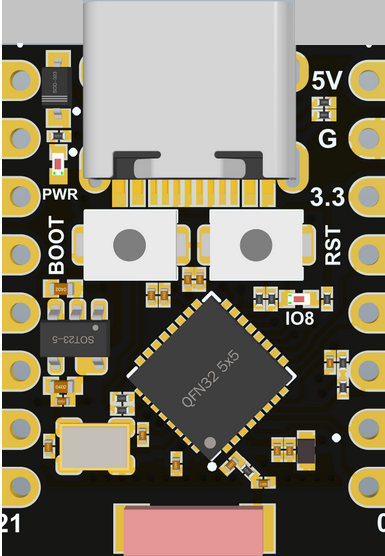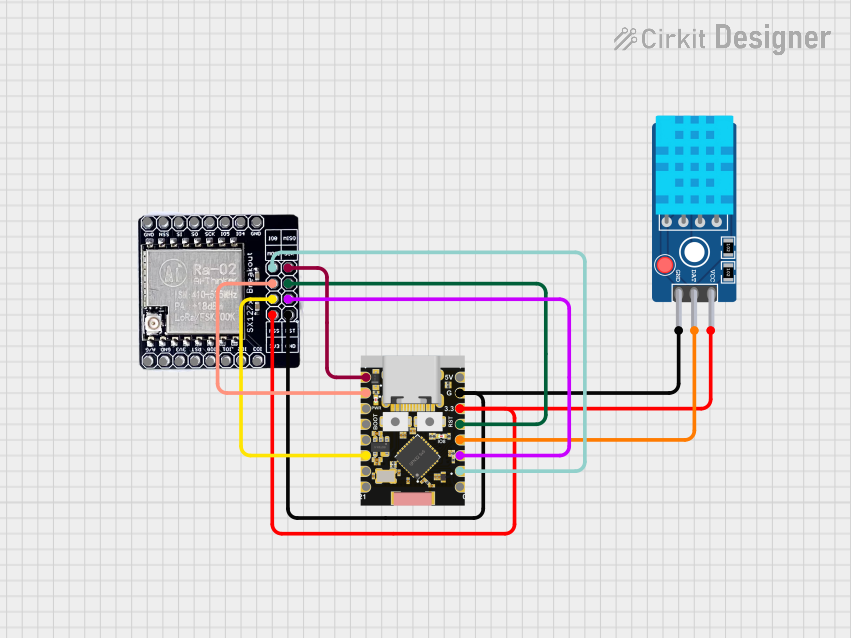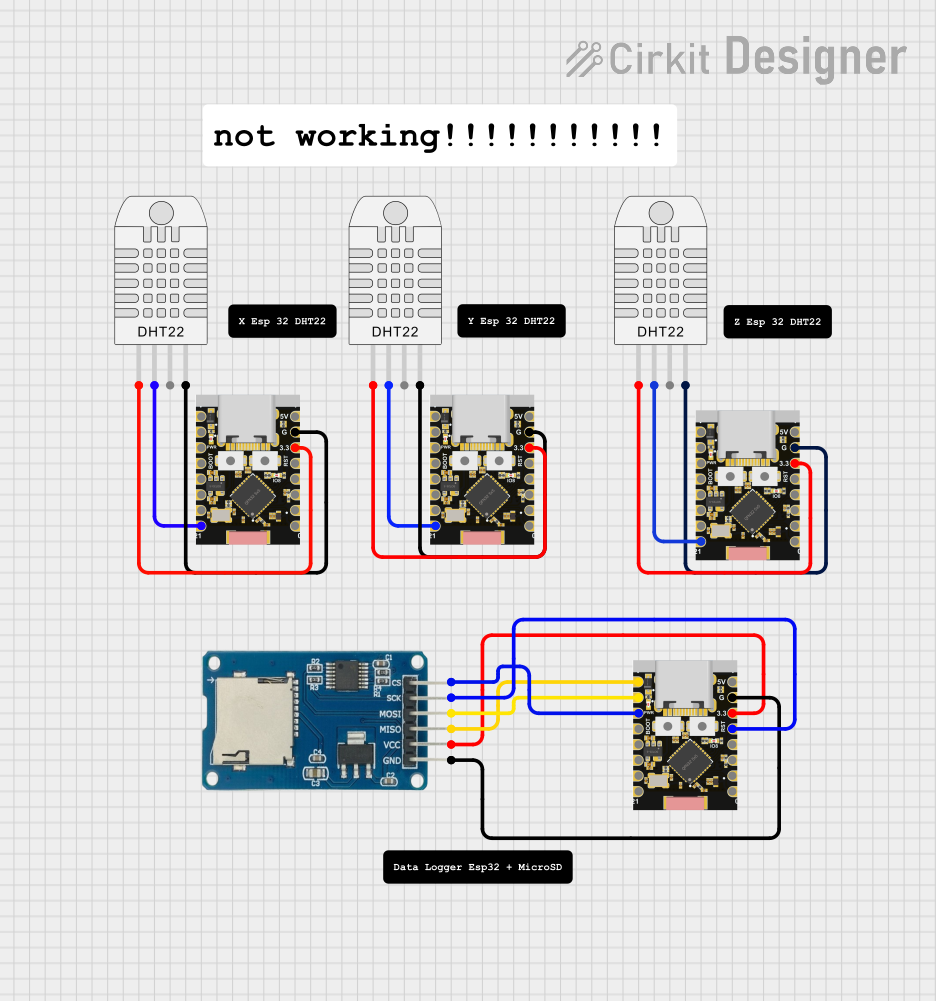
How to Use ESP32C3 Supermini: Examples, Pinouts, and Specs

 Design with ESP32C3 Supermini in Cirkit Designer
Design with ESP32C3 Supermini in Cirkit DesignerIntroduction
The ESP32C3 Supermini is a compact and powerful microcontroller module designed for Internet of Things (IoT) applications. It integrates Wi-Fi and Bluetooth connectivity, making it ideal for smart home devices, wearable electronics, and various wireless sensor networks. With its rich set of features and low power consumption, the ESP32C3 Supermini is suitable for a wide range of applications, from simple DIY projects to complex industrial systems.
Explore Projects Built with ESP32C3 Supermini

 Open Project in Cirkit Designer
Open Project in Cirkit Designer
 Open Project in Cirkit Designer
Open Project in Cirkit Designer
 Open Project in Cirkit Designer
Open Project in Cirkit Designer
 Open Project in Cirkit Designer
Open Project in Cirkit DesignerExplore Projects Built with ESP32C3 Supermini

 Open Project in Cirkit Designer
Open Project in Cirkit Designer
 Open Project in Cirkit Designer
Open Project in Cirkit Designer
 Open Project in Cirkit Designer
Open Project in Cirkit Designer
 Open Project in Cirkit Designer
Open Project in Cirkit DesignerTechnical Specifications
Key Technical Details
- CPU: 32-bit RISC-V single-core processor
- Clock Frequency: Up to 160 MHz
- Flash Memory: 4 MB
- SRAM: 400 KB
- Wi-Fi: 802.11 b/g/n (2.4 GHz)
- Bluetooth: Bluetooth 5.0 LE
- GPIO Pins: 22
- ADC Channels: 6
- DAC Channels: 2
- UART: 2
- SPI: 2
- I2C: 2
- PWM Channels: 8
- Operating Voltage: 3.0 to 3.6 V
- I/O Pin Voltage: 3.3 V (not 5V tolerant)
- Operating Temperature: -40°C to 125°C
Pin Configuration and Descriptions
| Pin Number | Function | Description |
|---|---|---|
| 1 | GND | Ground |
| 2 | 3V3 | 3.3V power supply |
| 3 | EN | Chip enable. Active high. |
| 4 | IO0 | General-purpose I/O and/or boot mode select. |
| ... | ... | ... |
| n | IO21 | General-purpose I/O. |
Note: This is a simplified representation. Refer to the actual datasheet for complete pinout information.
Usage Instructions
Integrating with a Circuit
Power Supply: Ensure that the ESP32C3 Supermini is powered with a stable 3.3V supply. Exceeding the voltage rating can damage the device.
GPIO Pins: When interfacing with other components, make sure that the voltage levels match the ESP32C3's 3.3V I/O levels to prevent damage.
Antenna: For optimal wireless performance, ensure that the antenna area is clear of metal objects and other sources of interference.
Programming: The ESP32C3 Supermini can be programmed using the ESP-IDF, Arduino IDE, or other compatible development environments.
Best Practices
- Use a decoupling capacitor close to the power supply pins to smooth out voltage spikes.
- Avoid running high-speed signals near the antenna to minimize interference.
- Implement proper ESD precautions when handling the device to prevent static damage.
Example Code for Arduino UNO
#include <WiFi.h>
// Replace with your network credentials
const char* ssid = "your_SSID";
const char* password = "your_PASSWORD";
void setup() {
Serial.begin(115200);
// Connect to Wi-Fi
WiFi.begin(ssid, password);
while (WiFi.status() != WL_CONNECTED) {
delay(500);
Serial.println("Connecting to WiFi...");
}
Serial.println("Connected to WiFi");
}
void loop() {
// Your main code would go here
}
Note: This code is for illustration purposes. Actual implementation may vary based on the specific requirements and the development environment.
Troubleshooting and FAQs
Common Issues
- Wi-Fi Connectivity Problems: Ensure the antenna is not obstructed and the Wi-Fi credentials are correct.
- Unexpected Resets: Check the power supply for stability and sufficient current capability.
- I/O Pin Damage: Verify that the voltage levels are within the specified range for the I/O pins.
Solutions and Tips
- Wi-Fi Reconnection: Implement a reconnection strategy in your code to handle temporary Wi-Fi outages.
- Power Supply: Use a regulated power source and avoid long power leads that can introduce voltage drops.
- ESD Precautions: Always ground yourself before handling the ESP32C3 Supermini to prevent electrostatic discharge damage.
FAQs
Q: Can the ESP32C3 Supermini be used with a 5V power supply? A: No, the operating voltage is 3.0 to 3.6V. Using a 5V supply can damage the microcontroller.
Q: Is the ESP32C3 Supermini compatible with Arduino IDE? A: Yes, it can be programmed using the Arduino IDE with the appropriate board support package installed.
Q: How many GPIO pins are available for general use? A: There are 22 GPIO pins available, but some may have specific functions, so check the datasheet for details.
For further assistance, consult the ESP32C3 Supermini's datasheet and the community forums dedicated to ESP32 development.